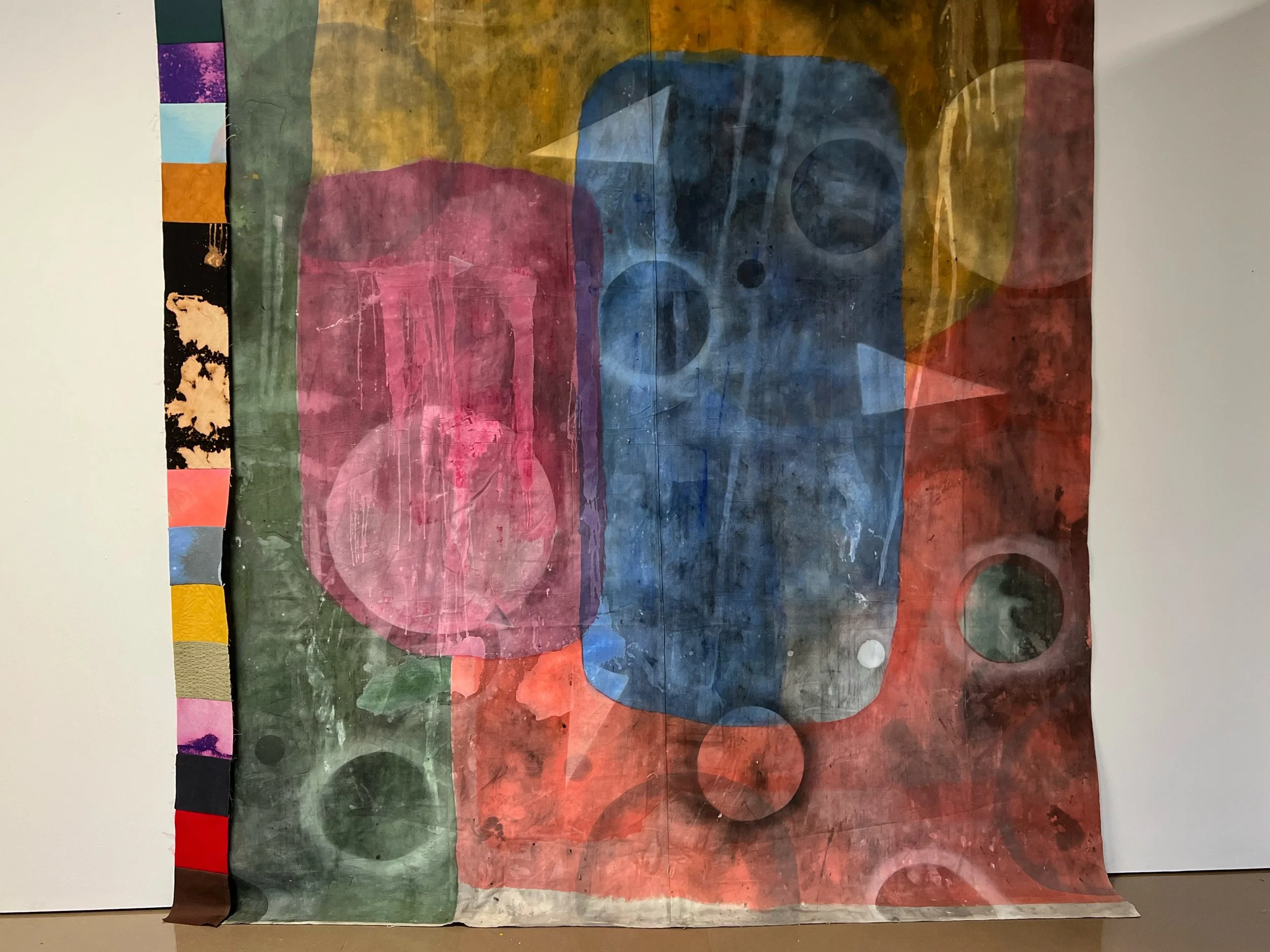Soft wall 2
Kylie Banyard, Soft wall 2, 2024, various reclaimed and plant dyed fabrics and cyanotype, 500 cm x 300cm. Image courtesy of the artist.
Transcript
This textile painting, titled Soft wall 2, created by Kylie Banyard, with the assistance of Saskia van Pagee Anderson, is displayed on the right-hand side of the sculptural installation. This artwork is made of various reclaimed and dyed fabrics and cyanotype. Cyanotype is a printing technique that involves exposing a light-sensitive material to the sun, by which patterns are created. The material is loosely pulled across a thin cylindrical piece of wood which has been hung from the ceiling using wires. This textile painting is approximately 3 metres high by 5 metres wide. The bottom edge of the textile painting lightly grazes the floor.
Working from left to right, there are eight vertical columns of material in a variety of widths. The first column is the thinnest. In this column, there are two sections of material, one above the other. In the top section, there are thin vertical stripes in purple, pink and brown. The section below is light green in colour.
Moving to the right, the second column is wider than the first. This column has two sections, also one above the other. Starting at the top, there is a slightly darker green patch and the material appears to be creased. Below this, there is a light grey patch with a light-yellow stripe running vertically on the right-hand side.
The next column is narrower than the last and includes two sections. Starting at the top, the material is dark blue with a light-blue vertical stripe on the right-hand side. Underneath this is a patterned fabric, consisting of geometric, angular shapes of rectangles and triangles that are jaggedly pieced together in colours of dark blue and white.
Moving to the right, the fourth column is slightly wider than the last. This column has a shorter patch at the top, and a longer patch at the bottom. The top patch is broken into two sections. On the left, there are soft muted colours of dark green, blue and dark purple swirling together, with bits of burnt orange and bright pink. On the right, the same colours are featured however are dispersed in a different swirling pattern. In the section below, splotches of bright pink and light purple are the dominant colours.
The fifth column is slightly narrower than the previous one. This column is broken into three sections with the top section being the shortest. This section is light pink with a few dark pink flecks visible. The next section down is bright blue with dark blue strokes, as if created from a paintbrush, positioned over the top of it. In the bottom section, the light brown creased material appears again. On the left-hand side of this column, starting from top to bottom, is a thin line of colour, with the top portion being grey and the bottom portion being peach. On the right hand side of column five, again running from top to bottom, is a thin pinstripe in the colour yellow, then purple, and then red.
Moving to the right, the sixth column is one of the widest columns on the textile painting. There are two sections, the top being longer than the bottom. The top section is a light-yellow colour on a wrinkled material, while on the bottom, the colour is an even lighter yellow, on a similar material.
Column seven is also quite wide and contains two sections, one above the other, with the top being longer than the bottom. The top section is a dark charcoal grey on similar wrinkled material. Below, the same light brown creased material is used.
Lastly on the far right and completing this art piece is column eight which is thin like the first column mentioned however this column is made of multiple patches of material which are sewed together, some in squares and some in rectangles, in colours of red, pink, green, blue, dark brown and burnt orange. The sewing is visible at the back of the artwork.

